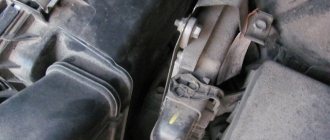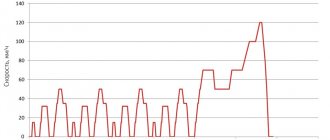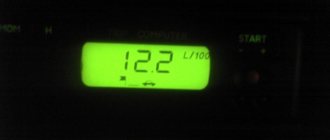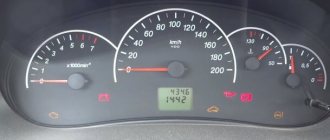Introduced in the fall of 2015, the Lada Vesta features improved aerodynamics and improved manufacturing quality. Fuel consumption on the Lada Vesta depends on the body type, operating conditions, driver experience and the combination of gearbox and engine used. A sharp increase in fuel costs indicates a system malfunction and the need to check the technical condition of the machine.
Lada Vesta with an all-metal body.
Technical characteristics of the Lada Vesta car
The Vesta car is equipped with an all-metal body designed to carry 5 passengers. The engine is mounted transversely in the engine compartment.
The front wheel suspension is of an independent type; the design includes struts with telescopic shock absorbers and springs.
To install the rear wheels, the plant used a semi-independent torsion beam equipped with shock absorbers and coil springs with nonlinear stiffness.
Technical parameters of Vesta (sedan model with 1.8-liter engine):
- body length - 4410 mm;
- width (excluding mirror housings) - 1764 mm;
- height (including antenna casing) - 1497 mm;
- wheelbase - 2635 mm;
- track (same for front and rear suspensions) - 1510 mm;
- ground clearance - 178 mm;
- luggage compartment capacity - 480 l;
- speed - up to 186 km/h;
- Acceleration time from zero to 100 km/h with gear changes is 10.2 seconds.
Factors that increase consumption
- curb weight of the vehicle;
- engine volume;
- type of pre-installed gearbox;
- size, height, width of tires;
- style and manner of management;
- condition of machine components;
- frequency of use of equipment in the car;
- temperature regime overboard.
Conclusion
Regardless of the type of preinstalled transmission, it is quite possible to reduce the “appetite” of the motor if you adhere to the described recommendations.
To reduce fuel consumption as much as possible, fill with AI-95 gasoline. In suburban mode, do not exceed the average speed of 90 - 95 km/h. The maximum permissible threshold is 100 km/h.
There is an opinion that filling third-party chemical additives helps reduce the “appetite” of the engine, gives power and acceleration dynamics. Service station fuel workers are wary of such statements, as they believe that this is more a marketing ploy than real savings. Of course, the final decision is up to the owner of the technical device.
Fuel consumption of Lada Vesta according to data from the factory
In-line 4-cylinder engines with distributed gasoline injection are available on Lada Vesta generation cars in 2021:
- licensed HR16 DE-H4M with a volume of 1598 cm³;
- standard VAZ-21129 with a volume of 1596 cm³;
- VAZ-21179 version with increased capacity to 122 liters. With. power.
HR16 DE-H4M (1600 cc, 117 hp)
For Lada Vesta cars, a 113-horsepower Nissan-Renault HR16 DE-H4M engine is offered, working in conjunction with a Jatco continuously variable variator with a torque converter clutch. The gasoline consumption declared by the plant in the urban cycle is 9.2 liters per 100 km.
In highway driving at a speed of 90 km/h and partially loaded, the car requires 5.9 liters of fuel. Tests have shown that in the combined cycle the engine burns 7.1 liters of fuel.
Lada Vesta with HR16 DE-H4M 117 hp.
VAZ-21129
The base 106-horsepower power unit is designed to work with a 5-speed manual transmission with overdrive top gear. Factory tests of a car with a standard sedan body showed that in city driving with stoppages at traffic lights and frequent acceleration, the engine burns 9.3 fuel.
In the mixed operating cycle, the parameter decreases to 6.9 liters per 100 km. Minimal gasoline consumption is possible when driving on a country highway at speeds of up to 90 km/h (the factory claims consumption at 5.5 liters).
In small batches, the plant produces 21129 CNG engines, designed to run on both gasoline and natural gas. A 90-liter compressed gas cylinder is installed in the luggage compartment, which has led to a reduction in useful capacity.
In the urban cycle, the power unit burns 10.1 liters of liquid fuel or 8.1 m³ of gaseous fuel; on the highway at a speed of 90 km/h the parameter drops to 6.0 l and 5.2 m³. The engine with a combined power supply system is only available for sedan vehicles equipped with a manual transmission.
Engine VAZ-21129.
VAZ-21179
From the beginning of 2021, the plant offers a 1.8-liter engine with a variable valve timing system, working with a 5-speed manual or robotic gearbox.
The increase in volume and power led to an increase in consumption in the combined cycle to 7.4 liters of fuel. In the city, according to factory measurements, the car delivers 9.5 liters per 100 km. On the highway at speeds up to 100 km/h, the sedan burns 6.2 liters of fuel.
There is a 145-horsepower engine modification installed on Lada Vesta Sport cars. Increased performance was achieved by using camshafts with a different cam profile, new firmware of the control unit and modifications to the gasoline injection system.
In city mode without sudden acceleration, the engine requires 10.6 liters of gasoline, and on the highway consumption increases to 6.4 liters (at 90-100 km/h).
When driving on the highway, 9.5 liters of fuel are consumed.
NE
The Lada Vesta SV or SW modification differs from the base model in having a 5-door station wagon body, which allows the transportation of cargo with increased dimensions.
The manufacturer produces modifications of the Vesta SW Cross, which are distinguished by additional exterior trim elements aimed at protecting the body and bumpers when driving on unpaved roads.
Model Vesta SW Cross.
Fuel consumption standards set by the factory for different types of engines and body trim are shown in the table.
| Motor | Vesta SW (city/highway/mixed) | Vesta SW Cross (city/highway/mixed) |
| HR16 | 9,6/6,1/7,4 | 9,6/6,1/7,4 |
| VAZ-21129 | 9,5/5,9/7,3 | 9,7/6,0/7,5 |
| VAZ-21179 | 10,6/6,3/7,8 | 10,7/6,4/7,9 |
Fuel consumption rate per 100 km
How much fuel does Lada Vesta consume and what factors affect it? The Lada Vesta has an average fuel consumption rate of 10 liters in the city and 8 liters on the highway. This is the standard specified in the technical documentation for the car. However, the norm is just that: it extremely rarely exists in reality. Various factors influence actual fuel consumption:
- type and size of installed engine;
- driving conditions and style;
- vehicle load;
- drive and transmission.
Thus, what consumption of the Lada Vesta will actually show will consist of these parameters and some other minor details. For example, engine contamination, wear of seals, and the use of low-quality motor oils increase fuel consumption.
As already mentioned, the consumption rate indicated in the passport is rarely achievable. An excellent result is considered if the actual consumption is 10-15% higher than the stated standard.
Real Lada Vesta consumption standards
The reviews left by the owners allow us to draw general conclusions about the efficiency of engines:
- When driving on a country highway at a speed of 90 km/h, the minimum fuel consumption is 6.5 liters. The parameter differs from the factory values due to inaccurate action on the gas pedal, errors when switching or selecting gears, as well as the road profile (passport data was obtained on a horizontal section of the highway). As the speed of movement increases and the weight of the machine increases, the consumption reaches 9 liters.
- When operating in urban conditions, the least economical cars are those with a 1.8-liter engine and a station wagon body. Owners note fuel consumption of up to 13 liters (when using air conditioning and transporting a payload weighing over 300 kg). The Vesta Sport modification burns up to 14 liters of gasoline during dynamic movement, but during quiet operation the consumption corresponds to the factory values.
- The operation of gaseous fuel vehicles shows that when driving in the city, the engine requires up to 9 m³ of fuel. In addition, the car requires a small amount of gasoline to start and initially warm up the engine. After reaching the set temperature, the controller shuts off the liquid fuel supply and connects the gas injection nozzles.
Recommendations for reducing fuel consumption
If you want to reduce consumption as much as possible, you need to try a little. To do this, take a few simple recommendations as a rule and regularly apply them when driving:
- Fill the gas tank only with the recommended brand of gasoline (AI-95).
- Monitor the tire pressure - it should always be normal.
- Try to use the brake pedal to a minimum - to do this, release the gas in advance and smoothly approach the stopping place (for example, to an intersection with a previously detected red signal).
- Accelerate as smoothly as possible, without slipping or abruptly pressing the pedal.
- Stick to the same economical speed when driving on the highway. It can be determined by the indicator of instantaneous consumption.
- Don't leave heavy items in the trunk - unload everything you don't need.
Depending on octane number
The plant allows the use of gasoline with an octane number of 92 units (except for the Vesta Sport modification), but due to the increased compression ratio, it is recommended to fill the tank with A-95 grade fuel.
An analysis of reviews from car owners shows that when using the A-92 in urban traffic, consumption increases by 0.5-0.7 liters (depending on the flow rate and load).
Certified values were obtained by the manufacturer during test runs using A-92 fuel that meets the standards. In actual operation, fuel does not always meet the standards.
It is recommended to refill the tank A-95.
The main reasons for increased fuel consumption
- If we ignore possible technical faults, there are not many reasons for increased fuel consumption. For example, driving with headlights constantly on, although it increases safety, also leads to a 5-10 percent excess consumption of gasoline.
- The same applies to the insufficient quality of the gearbox. If it does not “pull” at the required speed, then this may provide a slight increase in the amount of gasoline consumed.
- Do not try to buy gasoline with too low an octane rating. Such savings will immediately result in increased costs up to two times (!). And we’re not even talking about the wear rate of individual engine parts and the fuel supply system. If you use low-quality gasoline, you will have to drain the gasoline from the tank, and this cannot be done on a Lada Granta using old-fashioned methods!
- A non-obvious reason may be poor alignment of the wheel alignment system. This needs to be done twice a year, when you change your shoes to new tires. Problems may also arise when choosing a “sports” type of camber.
- Another reason is incorrect gaps set in the spark plugs.
However, as the drivers themselves say, a lot depends on the style of driving. It’s difficult to expect “factory” fuel consumption figures from someone who starts abruptly and stops just as abruptly. You can curb the car’s appetite only when it feels smooth, picks up speed carefully, and maintains it at high speeds for a long time, but with a minimum number of engine revolutions. Of course, this is difficult to achieve, especially in conditions of poor quality road surfaces, but you still need to try.
Methods for measuring gasoline consumption
To determine fuel consumption, the following methods are used:
- Using an on-board computer that reads data from the engine control unit. The device displays long-term or instantaneous consumption in l/100 km. The car owner can reset the result obtained during a long trip. Instantaneous consumption is updated in real time.
- Using arithmetic calculations based on an analysis of the amount of fuel consumed and the distance traveled. For example, the owner fills the tank until the cutoff is triggered, and then moves around the city or highway. After turning on the control lamp, you must again visit the same gas station and fill the tank to the full level. To determine consumption, divide the filled volume by the distance traveled. To increase the accuracy of the result, measurements are taken over several months.
Resetting Averages
Algorithm of actions when resetting information:
- Turn the ignition key to the “On” position.
- Find the top button at the end of the right lever located under the steering wheel, and then hold the button pressed for 2 seconds.
- Using short presses on the button, go to the section for adjusting the time that has passed since the last reset of the flow rates.
- Make sure that the indicators in the upper right part of the instrument cluster display (vehicle silhouette and 4-digit numeric field) are flashing, and then press the upper button on the right lever for 2 seconds. After resetting the time, information about average fuel consumption is deleted.
- To exit to the main screen of the on-board computer, press the lower key on the lever. There will be dashes in the fuel consumption field.
Fuel consumption indicator.
Statistics of fuel consumption on different Lada Vesta models
Lada Vesta has a number of different models. Depending on the configuration and the vehicle itself, the average fuel consumption figures also change.
| Lada Vesta model | Fuel consumption, l/100 km | |
| Document costs | Real numbers | |
| SW 1.6 | 5.7-9.2 | 6.5-10 |
| Cross Lux | 8-11 | 8.5-12 |
| SV Cross | 7.4-10.7 | 8-11.5 |
| SV 1.8 | 6-10 | 7-11 |
Reasons for excessive fuel consumption
Fuel costs are affected by:
- driving style;
- type of transmission and driver’s competence in using the box;
- type and quality of fuel and engine oil used;
- technical condition of the engine and transmission units;
- load on the on-board electrical network.
Driving style
The main reason for high fuel consumption on Lada Vesta cars is driving style. With sharp accelerations and upshifts at maximum engine speeds, gasoline consumption increases by 15-20%.
Driving at high speeds (more than 110 km/h), long periods of idle time with the engine and air conditioning running, as well as operating the vehicle in off-road conditions have a negative impact.
Transmission
When using a manual transmission, the driver must change gears in a timely manner, based on experience or on the prompts displayed on the display in the instrument cluster.
Models with a robotic or automatic transmission do not require human intervention, but the budget units used on the Lada Vesta do not help reduce fuel costs.
Poor quality fuels and lubricants
Filling a car with low-quality fuel leads not only to increased consumption, but also to damage to parts of the piston group, gas distribution mechanism and exhaust gas catalytic converter.
When using gasoline with a low octane number, detonation combustion of the mixture occurs, destroying the working chambers and reducing engine power.
The engine sump must contain oil that meets the factory requirements for base oil, viscosity and climatic zone in which the vehicle is operated.
Checking the quality of gasoline
Technical difficulites
Failure of the engine fuel supply system sensors or oxidation of the electrical wiring harness plugs leads to disruption of normal operation, difficult starting and a drop in efficiency.
Wheel hubs with worn bearings or seized brake calipers have a negative impact on fuel costs.
During operation, the air filter becomes clogged with dust, which reduces throughput. The engine does not develop the declared power, and the driver is forced to press the gas pedal harder, burning excess gasoline.
Operation of electrical appliances
The operation of electrical equipment has little effect on fuel consumption. The generator installed on the machines has a power of up to 2 kW and is equipped with control via a digital LIN bus.
Connecting a maximum load (for example, heated seats and windows) leads to an increase in fuel consumption by 100-150 ml per 100 km.
It should be taken into account that most current consumers in the machine are used for a short time, and a number of devices with a high level of energy consumption are turned on automatically (for example, a cooling fan electric motor).
Always use gasoline with the correct octane rating.
It goes without saying that you cannot use gasoline mixed with diesel fuel: after that you will have to change the oil. Filling the tank with fuel of a higher quality than recommended by the manufacturer has no effect.
The use of fuel with a lower octane number can cause two negative phenomena: self-ignition, which occurs before the working mixture is ignited by an electric spark, and detonation, which ultimately leads to a decrease in engine power and increased wear of valves, their seats, pistons, piston rings and spark plugs, not to mention simply increasing gas mileage.
Increased detonation is indicated by frequent engine knocking, similar to drumming. Detonation can lead to failure of the main and connecting rod bearings and piston pins. Only in some modern cars does the coordination of engine operation with fuel brand occur automatically; in others, it is necessary to change the ignition characteristics in accordance with changes in the fuel brand. The ignition in some cars can be adjusted by recoding the plug in the engine compartment to another characteristic (from 98 to 95 and from 95 to 93).
Comparison of consumption of 92 and 95 gasoline
Measurements carried out by car owners show that the cost of gasoline with an octane rating of 95 is 0.5-0.7 liters lower than when using A-92. The resulting difference compensates for the increased cost of A-95 grade fuel.
The advantages of using high-octane fuel are a reduced risk of detonation and increased engine power.
The disadvantages include a large number of additives in A-95 gasoline (especially for fuel supplied to gas stations of small companies), which settle on the electrodes of the spark plugs and impair the performance of the ignition system.
Appetites of the VAZ 21129 engine
The domestic product VAZ 21129 (1.6, 106 horses) can be equipped with two types of boxes and is often found on Lada Vesta. Gasoline consumption for cars with a manual transmission is at 9.3 liters in urban mode and 5.5 liters for suburban mode. Numbers for the AMT robot: 8.9 - city, 5.3 - suburban. The actual amount of fuel burned corresponds to the calculations of the manufacturer. In general, Vesta with a 1.6 engine consumes 7 liters in the combined cycle. 95 gasoline is recommended, but the engine can handle AI92.
Ways to save fuel
The main way to reduce fuel consumption to the level specified by the factory is to reduce the load on the engine. The driver needs to accelerate smoothly and use the vehicle's roll and engine braking mode.
When traveling on country highways, the speed should not exceed 100-110 km/h. Using an air conditioner increases the level of comfort, but the compressor requires 1 to 1.5 liters of fuel for every 100 km of travel. If the driver and passengers open the side windows, then due to increased aerodynamic resistance, consumption increases by 0.5-0.7 liters.
A drop in tire pressure negatively affects the vehicle's efficiency. A dirty air filter and towing a trailer have a negative impact.
Some owners install plastic deflectors along the door frames, which also increases fuel consumption.
The owner of the car needs to carry out routine maintenance in a timely manner with diagnostics of the electronics that control the operation of the power unit.
Reasons for high gas consumption on Lada Vesta
The “appetite” of the car’s engine can be adjusted, but only with a pre-installed mechanical gearbox. It is more difficult to do this with the robotic option; a lot of practice and experience is required.
With a manual transmission, everything is simple: exceed the speed - increase the consumption, reduce it - reduce the consumption. The situation is similar with the choice of speed. Often, when overtaking or maneuvering, it is necessary to quickly accelerate; for this, the driver switches to a lower gear to complete the overtaking.
In such situations, uncontrolled consumption of gasoline occurs. During peak loads, the on-board computer shows up to 30 - 40 liters per hundred.
The robotic version of the gearbox consumes 1.0 - 1.5 liters more. You can save on AMT only outside the city, on a flat road where there are no ups or downs. In the “stale” mode at a speed of 90 – 95 km/h you will save up to five liters.
Operating AMT on uphills, downhills, and serpentines only increases consumption. Activated car equipment also takes away the fuel supply: air conditioning, radio, portable digital gadgets, lighting system.
In winter, the “appetite” increases due to the constant operation of the stove heater and warming up the engine before the trip. Uneven tire pressure is the most common cause of gas mileage. Owners rarely check tire pressure, which is one of the reasons for high gas mileage.











